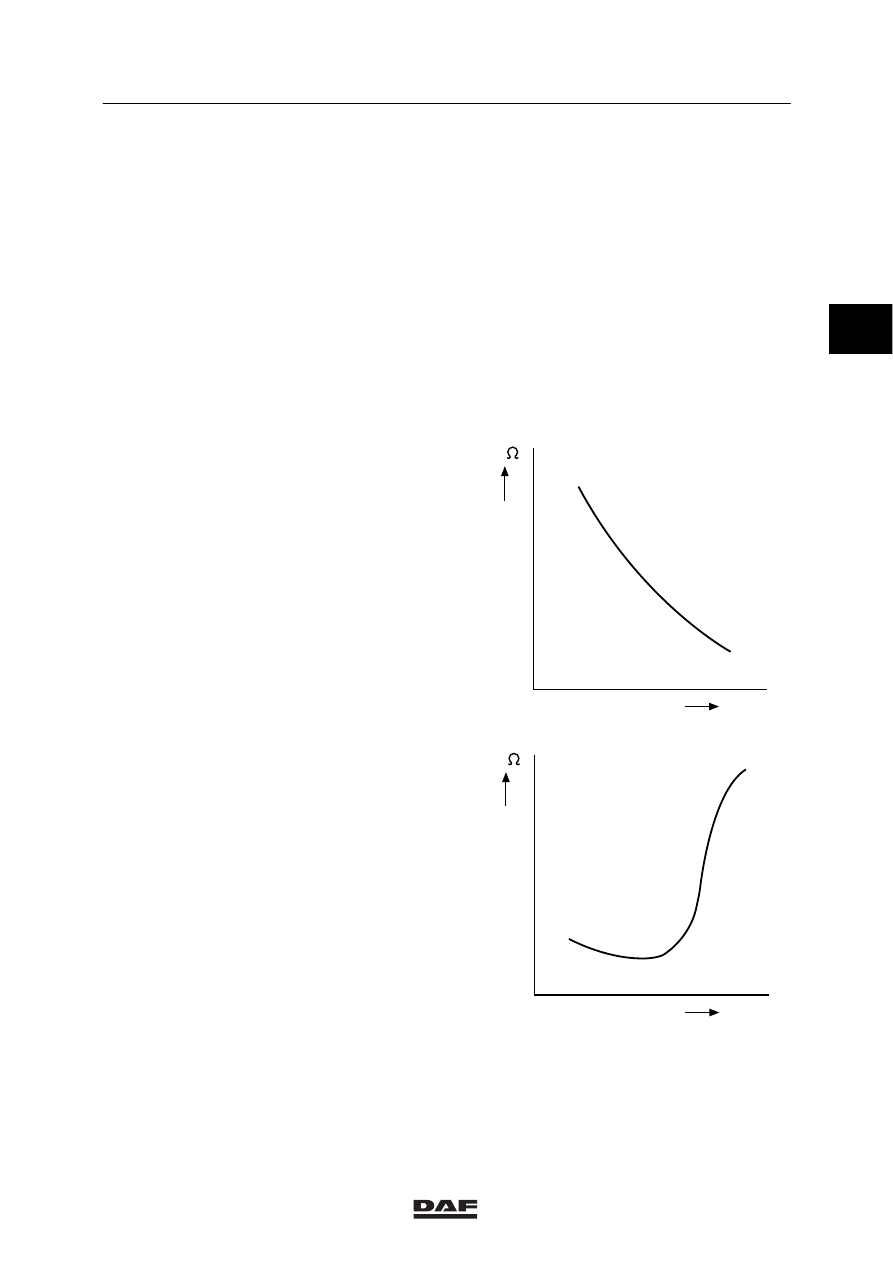DAF 95XF. Manual — part 231

5
Description of components
COMPONENTS
2-3
2.2 TEMPERATURE SENSORS
The vehicle is equipped with a number of
temperature sensors, such as:
-
coolant temperature sensor
These sensors (also called thermistors) are
resistors which are sensitive to temperature.
The resistance of these sensors changes
considerably when the temperature increases or
decreases.
There are two kinds of temperature sensor:
-
NTC resistor (Negative Temperature
Coefficient).
-
PTC resistor (Positive Temperature
Coefficient).
NTC resistor
In an NTC resistor, the resistor value decreases
as temperature increases.
Application:
-
measuring coolant temperature.
PTC resistor
In a PTC resistor, the resistor value increases
as temperature increases.
Contrary to NTC resistors, PTC resistors show a
large resistor difference within a small
temperature range.
Application:
-
measuring the air temperature in the
auxiliary heating.
Checking
The temperature sensors can be checked with a
multimeter set to the resistance range.
T ( C
° )
R ( )
W 5 01 010
T ( C
° )
W 5 01 011
R ( )
2
ǹ 9811

5
COMPONENTS
Description of components
2-4
2.3 FLUID-LEVEL SENSORS
The vehicle is equipped with a number of
fluid-level sensors, such as:
-
fluid-level sensor for the cooling system
The fluid-level sensor is a reed contact type.
The sensor is provided with a micro switch
which is influenced by a magnetic field outside
the sensor.
If the fluid level drops, the switch will be
operated by a float with a magnet in the tank or
reservoir, and the contacts will close.
The closing of the contacts will “activate” a
warning lamp.
Checking
The fluid-level sensors can be checked with a
multimeter set to the resistance range.
N
S
W 5 01 013
2
ǹ 9811

5
Description of components
COMPONENTS
2-5
2.4 PRESSURE SENSORS
The vehicle is equipped with a number of
pressure sensors, such as:
-
pressure sensor to register the bag
pressure in ECAS.
A diaphragm of semiconductor material (silicon)
is incorporated in the pressure sensor.
If pressure is exerted on the diaphragm, it will
bend.
This bending of the diaphragm will produce a
change of resistance of the semiconductor
material.
The diaphragm is part of a so-called bridge
circuit.
The bending of the diaphragm will unbalance
the bridge circuit, which causes the output
signal to change.
The output voltage is directly proportional to the
pressure applied (bending of the diaphragm).
Checking
The output voltage can be checked with a
multimeter set to the direct voltage range.
V
W 5 01 012
2
ǹ 9811

5
COMPONENTS
Description of components
2-6
2.5 PROXIMITY SENSORS
The vehicle is equipped with a number of
proximity sensors, such as:
-
sensor under the clutch pedal for E-throttle
-
cab lock sensor
-
mechanic rear axle lift system
Inductive proximity sensors
A changing electromagnetic field is generated
by a pulsating current in a coil (oscillation).
If a metal object is introduced into the
electromagnetic field, eddy currents will occur in
that metal object.
These eddy currents will “damp” the magnetic
field in the coil, so that the current taken up in
the coil will change.
This change will result in an output voltage.
Checking
Placing a metal object in front of the sensor
(inductive sensor) makes it possible to check
the output voltage with a multimeter set to the
direct voltage range.
W 5 01 014
E500551
2
ǹ 9811

Нет комментариевНе стесняйтесь поделиться с нами вашим ценным мнением.
Текст